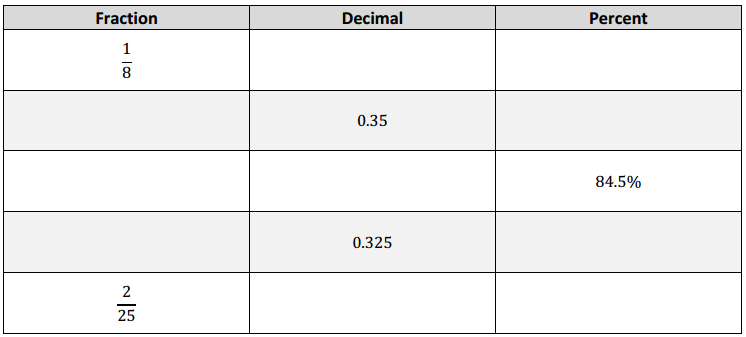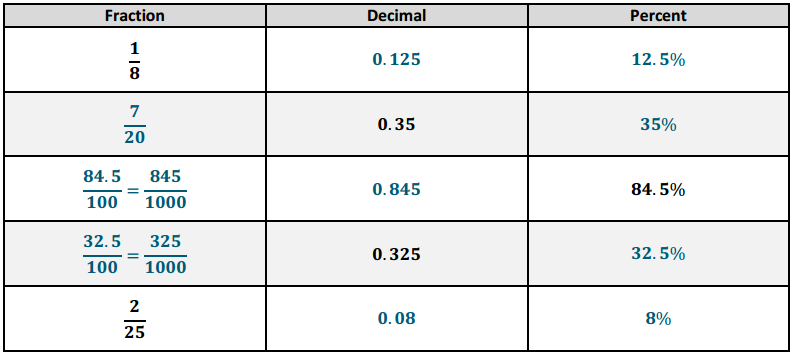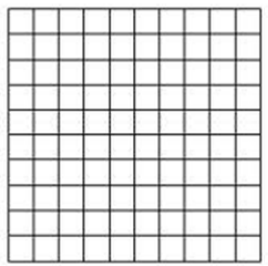Engage NY Eureka Math 6th Grade Module 1 Lesson 25 Answer Key
Eureka Math Grade 6 Module 1 Lesson 25 Example Answer Key
Example 1.

Sam says 50% of the vehicles are cars. Give three different reasons or models that prove or disprove Sam’s statement. Models can include tape diagrams, 10 × 10 grids, double number lines, etc.
Answer:
1. \(\frac{3}{5}=\frac{60}{100}\) → 60% are cars.
2. 
3. 50% = \(\frac{50}{100}=\frac{1}{2}\) 5 × \(\frac{1}{2}=\frac{5}{2}=2 \frac{1}{2}\) There are more than 2\(\frac{1}{2}\) cars.
1. How is the fraction of cars related to the percent?
Answer:
\(\frac{3}{5}\) is equal to \(\frac{60}{100}\). Since percents are out of 100, the two are equivalent.
2. Use a model to prove that the fraction and percent are equivalent.
Answer:

3. What other fractions or decimals also represent 60%?
Answer:
\(\frac{3}{5}=\frac{6}{10}=\frac{9}{15}=\frac{12}{20}=\frac{15}{25}\) = 0.6
Example 2.
A survey was taken that asked participants whether or not they were happy with their job. An overall score was given. 300 of the participants were unhappy while 700 of the participants were happy with their job. Give a part-to-whole fraction for comparing happy participants to the whole. Then write a part-to-whole fraction of the unhappy participants to the whole. What percent were happy with their job, and what percent were unhappy with their job?

Answer:

Create a model to justify your answer.
Answer:

Eureka Math Grade 6 Module 1 Lesson 25 Exercise Answer Key
Exercise 1.
Renita claims that a score of 80% means that she answered \(\frac{4}{5}\) of the problems correctly. She drew the following picture to support her claim.:

Answer:

Is Renita correct?
Answer:
Yes
Why or why not?
Answer:
\(\frac{4}{5}=\frac{40}{50}=\frac{80}{100}\) → 80%
How could you change Renita’s picture to make it easier for Renita to see why she is correct or incorrect?
Answer:
I could change her picture so that there is a percent scale down the right side showing 20%, 40%, etc. I could also change the picture so that there are ten strips with eight shaded.
Exercise 2.
Use the diagram to answer the following questions.

80% is what fraction of the whole quantity?
Answer:
\(\frac{4}{5}\)
\(\frac{1}{5}\) is what percent of the whole quantity?
Answer:
20%
50% is what fraction of the whole quantity?
Answer:
\(\frac{2 \frac{1}{2}}{5}\) or \(\frac{2.5}{5}=\frac{25}{50}\)
1 is what percent of the whole quantity?
Answer:
1 = \(\frac{1}{5}\) This would be 100%
Exercise 3.
Maria completed \(\frac{3}{4}\) of her workday. Create a model that represents what percent of the workday Maria has worked.
Answer:

She has completed 75% of the workday.
What percent of her workday does she have left?
Answer:
25%
How does your model prove that your answer is correct?
Answer:
My model shows that \(\frac{3}{4}\) = 75% and that the \(\frac{1}{4}\) she has left is the same as 25%.
Exercise 4.
Matthew completed \(\frac{5}{8}\) of his workday. What decimal would also describe the portion of the workday he has finished?
Answer:
5 ÷ 8 = 0.625 or \(\frac{5}{8}\) of 100% = 62.5%
How can you use the decimal to get the percent of the workday Matthew has completed?
Answer:
\(\frac{5}{8}\) is the same as 0.625. This is 625 thousandths or \(\frac{625}{1,000}\). If I divide both the numerator and denominator by ten, I can see that \(\frac{625}{1000}=\frac{62.5}{100}\).
Exercise 5.
Complete the conversions from fraction to decimal to percent.

Answer:

Exercise 6.
Choose one of the rows from the conversion table in Exercise 5, and use models to prove your answers. (Models could include a 10 × 10 grid, a tape diagram, a double number line, etc.)
Answer:
Answers willl vary. One possible solution is shown:

Eureka Math Grade 6 Module 1 Lesson 25 Problem Set Answer Key
Question 1.
Use the 10 × 10 grid to express the fraction \(\frac{11}{20}\) as a percent.

Answer:
Students should shade 55 of the squares in the grid. They might divide it into 5 sections of 20 each and shade in 11 of the 20.
Question 2.
Use a tape diagram to relate the fraction \(\frac{11}{20}\) to a percent.
Answer:
Answers will vary.

Question 3.
How are the diagrams related?
Answer:
Both show that \(\frac{11}{20}\) is the same as \(\frac{55}{100}\).
Question 4.
What decimal is also related to the fraction?
Answer:
0.55
Question 5.
Which diagram is the most helpful for converting the fraction to a decimal? ________________ Explain why.
Answer:
Answers will vary according to student preferences.
Eureka Math Grade 6 Module 1 Lesson 25 Exit Ticket Answer Key
Show all the necessary work to support your answer.
Question 1.
Convert 0.3 to a fraction and a percent.
Answer:
\(\frac{3}{10}=\frac{30}{100}\), 30%
Question 2.
Convert 9% to a fraction and a decimal.
Answer:
\(\frac{9}{100}\), 0.09
Question 3.
Convert \(\frac{3}{8}\) to a decimal and a percent.
Answer:
0.375 = \(\frac{375}{1000}=\frac{37.5}{100}\) = 37.5%